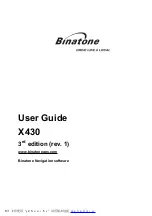
Flight Management System (FMS) for the Agusta AW139/AB139 Helicopter
A28--1146--181
REV 3 Mar 2009
Flight Plan
7-4
Honeywell International Inc. Do not copy without express permission of Honeywell.
Temporary waypoints are also created when a flight plan is loaded
from a disk, and either the FMS database does not contain the same
waypoint, or the waypoint definition is different. In this case, the
regular name of the waypoint is used preceded by a pound sign (
#)
.
For example, a flight plan is loaded containing the waypoint named
CEDA. CEDA is neither in the FMS navigation database nor defined
in the custom database. When CEDA is neither in the FMS
navigation database nor defined in the custom database, #CEDA is
displayed and the definition, specified in the loaded flight plan, is
used.
Altitude constraints for temporary waypoints are entered following
the temporary waypoint lateral definition. For example, entering
GBN/270/45/FL150 into the scratchpad is permitted. The FMS
creates a temporary waypoint from GBN on the 270 radial and at 45
miles. The waypoint can also have an altitude constraint of FL150.
D
Runway Extension Waypoints
-- The FMS creates temporary
waypoints on the runway extension line. Once a runway has been
activated into the active flight plan, line selecting to the scratchpad
is permitted. When displayed in the scratchpad, the runway is in the
following format: AIRPORT.RUNWAY/BEARING/. A distance is
permitted to be inserted to complete the definition of a waypoint on
the extension line of the runway. Entering an altitude constraint
following the distance is also permitted. Insert this definition into the
flight plan to create a temporary waypoint. Repeat the process with
varying distances to create a number of waypoints on the extension
line.
When the runway is at the origin, the bearing brought to the
scratchpad is the runway heading permiting waypoints on the
departure path.
When the runway is at the destination, the bearing brought to the
scratchpad is the reciprocal of the runway heading permiting
waypoints on the arrival path.
D
VNAV Offset Waypoints
-- Air Traffic Control (ATC) often clears an
aircraft to cross a specified distance before or after a waypoint at a
specified altitude. These are called VNAV offset waypoints.
D
Origins and Destinations
-- Origins and destinations are any
waypoint contained in the database. This includes any pilot--defined
waypoints. Origins and destinations of the active flight plan are
permitted to be temporary waypoints. Origins and destinations are
normally airports. The origin or destination must be an airport
defined in the navigation database to activate the respective
runway, SID, STAR, or approach.
Summary of Contents for FMZ Series
Page 3: ......
















































